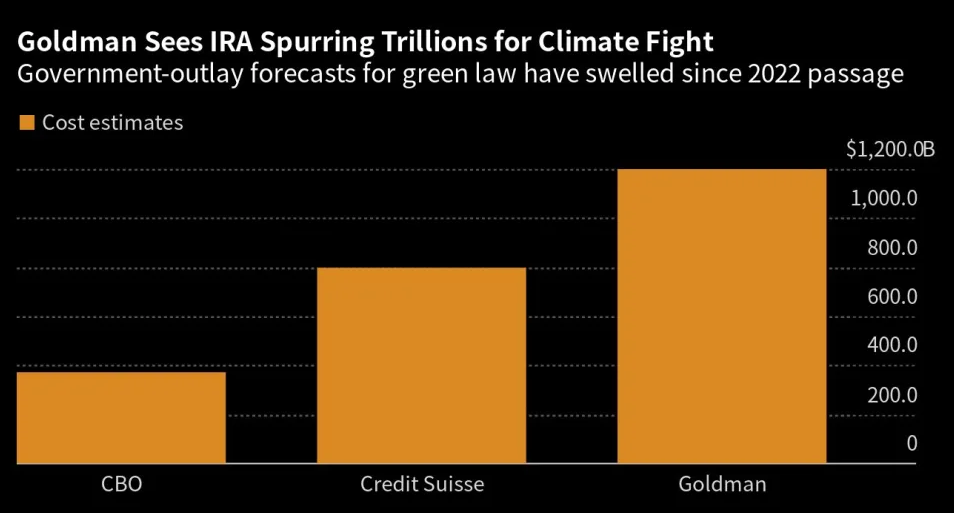President Joe Biden’s Inflation Reduction Act (IRA) will cost roughly $1.2 trillion–three times more than the official government forecast. The Act passed last year is intended to encourage investment in renewable-energy sources and efficiency technology, and is crucial to the Biden administration’s priority of decarbonizing the economy. The act — passed solely by Democrats — used accounting gimmicks to claim the law would reduce the budget deficit and reduce carbon dioxide emissions by 40 percent by 2030. The Congressional Budget Office (CBO) forecast that the IRA’s energy and climate provisions would cost $391 billion between 2022 and 2031–a huge under-estimate. The difference in cost mainly arises from lucrative tax credits in the law that are not capped and that the Biden Administration is loosely interpreting conditions for those credits, driving their costs up.
The new cost forecast by Goldman Sachs shows the IRA tax credits will cost tens to hundreds of billions more than CBO estimated over the next 10 years. The forecast differences include electric vehicles (difference: $379 billion), “green energy” manufacturing ($156 billion), renewable electricity production ($82 billion), energy efficiency ($42 billion), hydrogen ($36 billion), biofuels ($34 billion) and carbon capture ($31 billion). The difference in the EV credit estimates is due to the projection that more vehicles will meet the law’s “self-sufficiency” mineral and battery material conditions for the partial $3,750 consumer credit and full $7,500 credit.

However, even those estimates could be low if Biden’s Treasury Department loosely interprets the credit conditions. The Mercatus Center projected that the tax credit for battery production could cost up to $196.5 billion because auto manufacturers are racing to take advantage of a tax credit for locally manufactured battery cells and modules by setting up plants in the United States. Just one plant, Ford’s Michigan plant with Chinese battery maker CATL, could cost $1.5 billion annually in credits. Goldman Sachs estimates the tax credit could cut the cost of battery production by 35 percent to 42 percent, though electric vehicles would still cost 17 percent more than vehicles with internal combustion engines.
The Inflation Reduction Act provides a tax credit of $35 per kilowatt-hour for the production of batteries used in electric vehicles — roughly 35 percent of the cost to fabricate a cell using current methods. Initial estimates from the CBO determined the cost of the program at $30.6 billion over the next 10 years. Following new battery investments totaling more than $73 billion in 2022, Benchmark Mineral Intelligence expects the program to cost at least $136 billion over the next 10 years– more than four times the $30.6 billion estimated by the CBO.
Companies are expected to make billions from taxpayers because of the IRA provisions, with Tesla expecting to earn $1 billion in battery tax credits in 2023, and $17.5 billion between 2023 and 2026. Its Nevada plant will soon be able to produce 100 gigawatt-hours of battery cells, and that could grow to 500 gigawatt-hours in the future. At an annual production rate of 500 gigawatt-hours, the credits would be worth $17.5 billion per year. Ford expects to receive $7 billion in breaks from 2023 to 2026 before spiking in 2027, and GM expects to earn $300 million in 2023, with the credits eventually being worth $3,500 to $5,500 per vehicle.
Because the IRA requires that vehicles be manufactured in the United States to qualify for a $7,500 consumer tax credit, foreign automakers like Japan’s Honda and South Korea’s Hyundai announced plans for multibillion-dollar electric vehicle manufacturing plants in the United States in 2022.
Conclusion
President Biden has a goal to get 50 percent of all new vehicles sold in the United States to be electric by 2030 and to decarbonize the U.S. economy by 2050. To reach those goals, the administration wants to invest in climate infrastructure and does not mind making taxpayers, who are already suffering from high inflation, fund lucrative tax credits. Some are now estimating the EV tax credits will cost over four times as much as predicted when the bill was passed and that overall the bill will be 3 times more costly, increasing inflation through government spending, rather than reducing it as the title of the law claims.
EV operating costs are beginning to mount for consumers, with increasing electricity prices and 27 percent higher insurance costs on average than internal combustion vehicles. Through the IRA subsidies the government is picking winners and losers, and history has shown that the government usually fails when it interferes with the market and consumer choices. The Democrat-controlled Congress in 2022 created an enormous new corporate entitlement whose costs will increase dramatically and increase the deficit while raising energy prices for Americans.